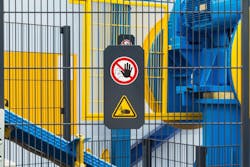Machine Safety Implications for OEMs and End Users
Nearly every industrial company cites worker safety as its top priority. But making statements about safety is very different from actual implementation. With standards varying around the world and governmental directives being so broad that they often don’t provide exact guidelines, machine safety can be a challenge for machine manufacturers and end users alike.
A lack of clarity around machine safety was apparent in responses to a recent survey of Automation World readers, where we received numerous questions on the topic of machine safety as it relates to responsibilities for OEMs and end users, assessing legacy and new equipment, and adherence to various local and international standards. To help clarify these issues for our readers, we connected with two representatives from Omron Automation—Todd Mason-Darnell, marketing manager of services and safety, and Pamela Horbacovsky, a safety product manager—for a recent episode of the “Automation World Gets Your Questions Answered” podcast series.
Recognizing that, for U.S. manufacturers, OSHA will be the biggest driver of machine safety requirements through its standards such as OSHA 1910.147, 1910.212, and 1910.219, as well as its general duty clause that manufacturers “shall” provide a safe workplace so that workers are not exposed to an unacceptable level of risk, Mason-Darnell said that Omron approaches the subject by working with end users to develop a safety strategy for the plant. We help them focus on what they “want functional safety to look like and then to make all stakeholders in the plant aware of it,” he said.
Mason-Darnell noted that, in the U.S., it’s up to end users to drive machine safety specifications to OEMS. “Most OEMs are not going to guard a machine or implement functional machine safety unless the end user specifies it,” he said.
Even though machine safety must be driven by end users in the U.S., Horbacovsky said OEMs can provide additional value by “developing ‘good enough’ safety for their equipment by adding basic devices like emergency stops or safety light curtains to their machines. This can extend to troubleshooting tools, real-time monitoring, and sending safety information to the cloud so that a safety strategy can be developed from this.
Environmental effects
It’s not unusual to conduct machine safety assessments based purely on machine functions and operator interaction points with the machine, but environmental aspects should be equally important considerations.
Thin about laser scanners, for example, Mason-Darnell said. In clean factory environments, the kind of scanner will work well, but in a manufacturing environment with high dust levels, that scanner will not be functional. This applies to temperature issues as well. It even extends to the location of the equipment.
“We had a case where a customer had done a risk assessment and guarded a machine properly, but then moved the machine to another location in the factory next to a stairwell,” said Mason-Darnell. “This allowed workers to step up a couple of steps and reach over the guarding that had been placed on the machine so that they could make adjustments. The company had not considered the environmental factors that would allow a worker to reach over, under, or around the guarding. Risk assessments and ensuing safety implementations can’t be done in the abstract, they have to be made in the environment in which the machine will operate.”
Considering the high costs associated with retrofitting legacy equipment for functional machine safety, Mason-Darnell said it’s critical to first understand where the greatest risks lie and getting those into compliance first before resolving other safety issues. “You have to realize that, with older equipment, schematics will often have been lost and repairs and patches will have been done. When you go in to do retrofitting, it can be kind of like ‘Indiana Jones and the Lost Control System’ when you open up a panel and there’s nothing but spaghetti in there with six different colors of wire. Be aware that, when you’re retrofitting safety as part of your functional machine safety journey, it’s going to take longer than you think and cost more than you expect. There can definitely be sticker shock when bringing old equipment into compliance.”
Global standards
Regardless of which standards you need to adhere to based on the geographic location of the machinery, the most important aspect of functional machine safety is the risk assessment, said Horbacovksy. With all the standards available through ANSI and ISO, there are several options to follow in developing the functional safety design of a machine. “A good starting point is ANSI B11.19 as it provides a growth perspective around developing safety solutions and techniques. As long as you follow one of these standards groups, either ANSI or ISO, you’ll be compliant, but also keep in mind additional requirements and regulations in the areas where the machine will be used.”
“OSHA will not tell an end user specifically what to do,” said Mason-Darnell. “They’ll just refer to a specific standard to be followed. That’s why we’re now seeing greater harmonization across standards, like with ANSI and ISO, because of the machine safety challenges faced by OEMs worldwide. For example, Brazil’s NR12 regulatory standard was always on its own, now it’s being brought in line with these other standards.”
Since Europe has the strictest directives around machine safety, more OEMs are increasingly designing machines to comply with Europe’s Machinery Directive. Mason-Darnell said this means those machines would generally be compliant everywhere, “but you still need to be careful about that in light of local regulations.”
About the Author
David Greenfield, editor in chief
Editor in Chief

Leaders relevant to this article:


